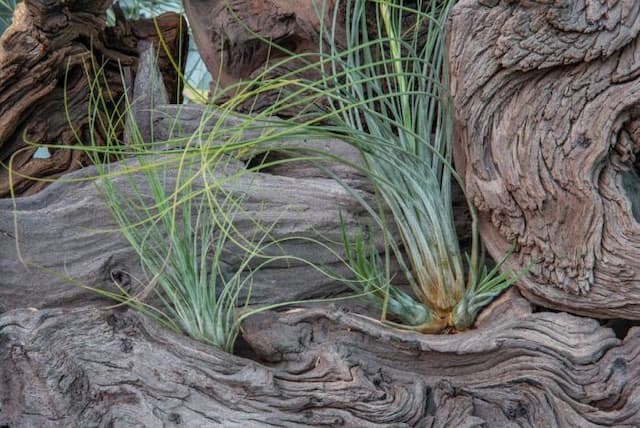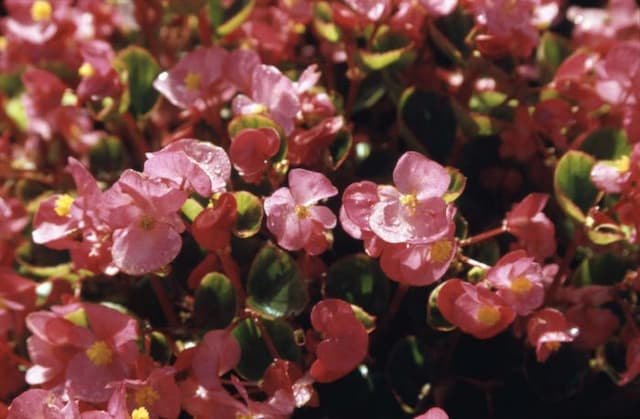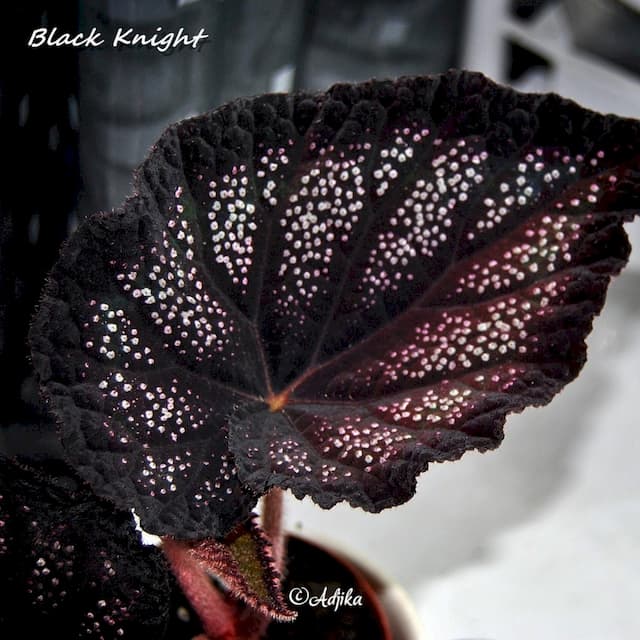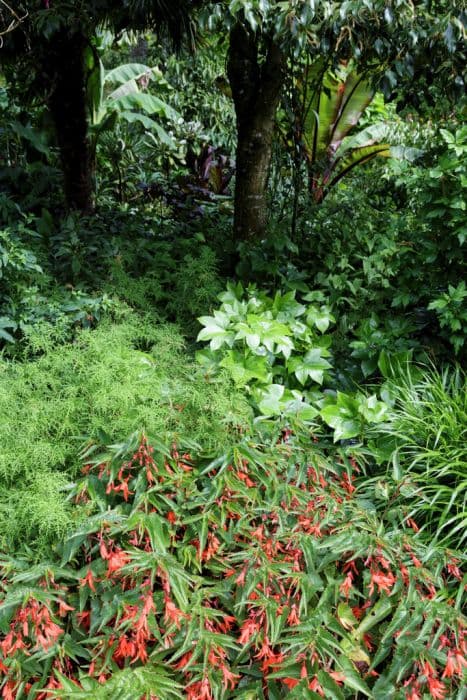Escargot Begonia Begonia 'Escargot' (R)

ABOUT
Begonia 'Escargot' is named for its unique foliage that resembles the spiral shape of a snail's shell. Each leaf is strikingly spiraled, giving it a distinctive whorled appearance that draws the eye. The leaves themselves are a lush green, banded with a silvery sheen that emphasizes the spiral and provides a beautiful contrast to the deep green color. Around the edges of the leaves, a subtle hint of reddish-brown can often be seen, adding depth and complexity to the plant's appearance. The texture of the leaves is another notable feature; they are quite thick and puckered, with a ruffled or crinkled feel that adds to the visual interest. In terms of coloring, foliage with such intricate patterning and texture makes Begonia 'Escargot' stand out as an ornamental and desirable houseplant.
About this plant
 Names
NamesFamily
Begoniaceae.
Synonyms
Escargot Begonia, Snail Begonia.
Common names
Begonia 'Escargot'.
 Toxicity
ToxicityTo humans
Begonias, including the Escargot Begonia, contain compounds that can be mildly toxic to humans if ingested. They possess oxalate crystals, which can cause irritation to the mouth, lips, throat, and gastrointestinal tract upon consumption. Symptoms of ingestion may include a burning sensation, swelling, and difficulty swallowing. Nausea and vomiting could also occur in some individuals, although severe poisoning is rare.
To pets
Escargot Begonia is also toxic to pets due to the presence of insoluble oxalates. If a pet ingests any part of the plant, it can lead to symptoms such as oral irritation, drooling, vomiting, and difficulty swallowing. Pets might also paw at their faces or exhibit signs of distress. It is important to keep these plants out of reach of pets to avoid any accidental ingestion.
 Characteristics
CharacteristicsLife cycle
Perennials
Foliage type
Evergreen
Color of leaves
Mixed
Flower color
Pink
Height
1 foot [30 cm]
Spread
1 foot [30 cm]
Plant type
Herb
Hardiness zones
10
Native area
Central America
Benefits
 General Benefits
General Benefits- Aesthetic Appeal: Adds a unique visual interest to gardens and indoor spaces with its spiral-shaped leaves and attractive coloration.
- Low Maintenance: Requires minimal care, which makes it suitable for busy gardeners or those new to plant care.
- Versatility: Can be used in various garden designs, including container gardens, terrariums, and as a houseplant.
- Enhances Mood: The presence of plants like the Escargot Begonia can improve mood and create a calming environment in a home or office.
- Cooling Effect: Through the process of transpiration, the Escargot Begonia can help slightly lower the surrounding temperature, contributing to cooler ambient conditions.
 Medical Properties
Medical PropertiesThis plant is not used for medical purposes.
 Air-purifying Qualities
Air-purifying QualitiesThis plant is not specifically known for air purifying qualities.
 Other Uses
Other Uses- Art and Craft Material: The unique spiral pattern of Begonia 'Escargot' leaves can be used in pressed flower art or as inspiration for designs in various crafts.
- Photography Subject: Due to its striking appearance, the Begonia 'Escargot' is a popular subject for photographers, especially those specializing in plant and nature photography.
- Educational Tool: The distinct leaf pattern can be used to teach botanical concepts and plant morphology in educational settings.
- Culinary Garnish: Although not commonly used for consumption, the leaves could potentially be used as a decorative garnish for specialty dishes in high-end culinary presentations.
- Fashion Inspiration: Designers may draw inspiration from the swirl pattern of the leaves for prints and patterns in clothing and accessory design.
- Religious Ceremonies: In some cultures, unique plants like Begonia 'Escargot' may be used as offerings or decorations in religious ceremonies due to their exceptional beauty.
- Aquascaping: While not an aquatic plant, the leaves of Begonia 'Escargot' could inspire the design and layout of aquascapes in fish tanks and aquariums.
- Wedding Decor: The elegant spirals of the leaves can be incorporated into wedding bouquets or table centerpieces for a botanical theme.
- Color Palette Inspiration: Artists and interior designers might use the plant's coloration as the basis for a color palette, drawing from its green hues and reddish-purple undertones.
- Personalization of Space: People might use the distinct Begonia 'Escargot' to make a statement in personal spaces such as work desks or home office plants, reflecting individual style and preference.
Interesting Facts
 Feng Shui
Feng ShuiEscargot Begonia is not used in Feng Shui practice.
 Zodiac Sign Compitability
Zodiac Sign CompitabilityEscargot Begonia is not used in astrology practice.
 Plant Symbolism
Plant Symbolism- Caution: The spiral shape of the Begonia 'Escargot' leaves can suggest caution or to proceed slowly, akin to the shell of a snail, which symbolizes measured and deliberate movement.
- Uniqueness: The unusual, almost geometrical form of Begonia 'Escargot' leaves represents uniqueness or standing out from the crowd, due to its distinctive spiral-shaped foliage.
- Individuality: Each Begonia 'Escargot' leaf can twist in its own unique way, symbolizing individuality and the celebration of differences.
 Water
WaterWatering Escargot Begonia involves keeping the soil consistently moist but never waterlogged, as they are prone to root rot. During active growth in spring and summer, water Escargot Begonias thoroughly once the top inch of soil feels dry, typically about once a week. Reduce watering in the fall and winter to every other week or less, as growth slows down. When watering, use room temperature water, and apply enough to saturate the soil without leaving standing water; this usually amounts to approximately 8-16 ounces depending on pot size. Avoid splashing the leaves to prevent fungal diseases.
 Light
LightEscargot Begonia thrives in bright, indirect light but can tolerate moderate light conditions. The best spot for an Escargot Begonia is near an east or north-facing window where it will receive plenty of light without being exposed to the harsh midday sun. Direct sunlight can scorch the leaves, so if south or west exposure is all that's available, diffuse the light with a sheer curtain or place the plant slightly away from the window.
 Temperature
TemperatureEscargot Begonias prefer temperatures between 60 and 70 degrees Fahrenheit, which are typical indoor conditions. They can tolerate a minimum temperature of around 50 degrees Fahrenheit, but anything lower might damage the plant. The maximum temperature they can endure is around 75 degrees Fahrenheit, but ensure there is good air circulation to prevent overheating and disease. Always protect your Escargot Begonia from drafts and sudden temperature changes.
 Pruning
PruningPrune Escargot Begonia to remove dead or dying leaves and encourage a bushier growth habit. Snip off the old flowers to promote new blooms and maintain the plant's aesthetic appeal. Pruning is best done in the spring or early summer, when the plant is entering its active growing season. You don't need to prune Escargot Begonia often; a light annual trim to shape the plant and remove any unhealthy foliage is generally sufficient.
 Cleaning
CleaningAs needed
 Soil
SoilThe best soil mix for the 'Escargot' Begonia is one that is rich in organic matter, well-draining, and lightweight. A mixture of peat moss, perlite, and vermiculite is ideal. The soil pH should be slightly acidic to neutral, ranging between 5.5 and 6.5 for optimal growth.
 Repotting
Repotting'Escargot' Begonia should be repotted every 1-2 years or when it outgrows its current container. Repotting is best done in the spring or summer when the plant is actively growing.
 Humidity & Misting
Humidity & Misting'Escargot' Begonia thrives in high humidity conditions, ideally between 50% and 70%. It benefits from regular misting or placement on a pebble tray with water to increase the surrounding humidity.
 Suitable locations
Suitable locationsIndoor
Bright, indirect light and consistent moisture promote indoor growth.
Outdoor
Sheltered from wind, partial shade, moist, well-draining soil.
Hardiness zone
10-11 USDA
 Life cycle
Life cycleThe life of Begonia 'Escargot' begins with germination, where the spiral-patterned foliage starts to develop from seeds or leaf cuttings in a warm, humid environment. The plant then enters a vegetative state, where it forms a rosette of leaves and continues to grow, producing more 'escargot' shaped leaves over time. During its growth, if conditions are optimal with indirect light and proper moisture, it will reach maturity and can produce small clusters of flowers, although the main attraction remains the foliage. After flowering, which is not the main feature, Begonia 'Escargot' continues to put its energy into leaf production rather than seed development. As an evergreen perennial, it doesn't have a distinct dormancy period but will grow more slowly during the cooler, darker months. Over the years, if the plant becomes too large or starts to decline, it can be propagated by dividing the rhizomes or from leaf cuttings, thus continuing its life cycle.
 Propogation
PropogationPropogation time
Spring-Summer
The popular method to propagate Begonia 'Escargot' involves leaf cuttings, which is best done during the warm growing season, from late spring to early summer. To do this, a healthy, mature leaf is chosen and a few incisions are made on the major veins on the underside of the leaf. This leaf is then laid flat on a moist potting mix surface, with the cut side down, and gently pinned in place. The pot should then be covered with plastic to maintain high humidity and placed in a warm, indirect light location. Roots and new shoots usually develop at the sites of the cuts, and once they've grown enough, usually in a couple of weeks to a month, the new plantlets can be separated carefully and potted individually.





![Begonia [Allure]](/_next/image?url=https%3A%2F%2Fplants-admin.emdemapps.com%2Fimages%2Fplants%2F%2Fimages%2F604b5b9006ab9.png&w=640&q=75)



